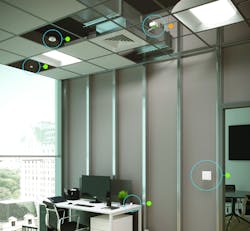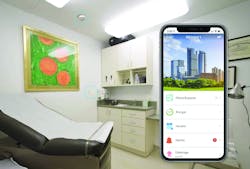Seven Trends Shaping the Lighting & Control Industry Today
Lighting was in the midst of a substantial transformation long before March 2020. Smart lighting control systems introduced us to the opportunity for more dynamic, responsive environments, and wireless solutions began making design, installation, and management easier, faster, and more future-proof. Although intensified and accelerated by the pandemic, these changes will continue to shape the industry for years to come.
We can step back and consider two common themes that continue to surface — demand for flexibility and a desire for enhanced user experiences through light. In response, electrical contractors and engineers can add value for their customers by delivering effective, quick solutions through smart design and responsive, scalable technology. Following are seven trends in the lighting and controls arena that electrical professionals should continue to watch for the rest of this year and beyond.
#1: Market volatility makes flexibility even more important
Especially among commercial contractors, ongoing labor shortages combined with volatility in the supply chain require increased planning to decrease risk and protect profit margins.
In the latest U.S. Chamber of Commerce Commercial Construction Index (CCI), 88% of contractors report a high-to-moderate level of difficulty in finding skilled labor, and 35% of contractors said they turned down commercial projects because of the worker shortage. Installing wireless lighting controls helps contractors get more done with their current staff, stay on schedule, and deliver within budget.
Anecdotal evidence seems to indicate that electrical engineers are having their own issues with the labor market. In the early stages of the pandemic, many engineers were laid off, as noted in a related article in FierceElectronics. Even as the work returns, electrical engineers are not necessarily being rehired at the same rate, potentially resulting in more work for fewer people. The Bureau of Labor Statistics anticipates demand for electrical engineers to grow by 7% between now and 2030. This also could mean more work for fewer people. To handle the increased workload, solutions that are simple to design, capable of meeting diverse project requirements, and easily scalable are beneficial.
Wireless lighting control can help you manage labor issues while meeting your design needs. They are up to 70% faster to install than wired solutions because there is minimal need to open walls or for pulling new wire. In addition, it is also easier to add or adjust wireless sensors, controls, and even smart hubs at any time during project design or installation, ensuring you can do more with the team you have.
Supply chain volatility and lack of product availability are also keeping engineers and contractors up at night. In the second quarter of 2021, just under half (46%) said unreliable product availability was their top concern, according to the U.S. Chamber of Commerce’s Commercial Construction Q2 2021 report. Of particular interest to electrical contractors is the supply and price of copper, which seems to fluctuate on a daily basis. A recent headline in Barron’s reads, “Copper Prices Just Fell to a Dangerous Level. What that Means for the Economy,” while only a few months ago, some analysts predicted that the price of copper would continue to rise through 2025 in a CNBC piece on its futures and commodities page.Compared to traditional, wired solutions, wireless lighting controls are uniquely positioned to help overcome barriers and maximize profitability. Wireless helps reduce the need for materials like wire and conduit and can help electrical contractors circumvent volatility concerns on their jobs. Depending on the manufacturer, systems can be custom designed using standard components that are readily available from stock at a local distributor. This insulates electrical contractors from risk and allows them to effectively manage the inevitable changes to a project’s bill of materials.
#2: Touchless controls have gone from a “nice perk” to “must have”
As revealed in “Office Re-Entry Index Vol. II” from LaSalle Network, a June survey of 350 CEOs and other corporate leaders found that more than 70% of businesses expect to bring employees back to the office by fall 2021. At the same time, 40% of American adults report higher levels of anxiety since the COVID-19 pandemic began. As employees settle back into the shared workspace, they want assurances that it has been updated to minimize shared surfaces and reduce germ transmission wherever possible.
Contactless lighting controls are one way to help employees avoid a high-touch area and give them greater control over their personal environment. With the Center for Disease Control and Prevention (CDC) encouraging businesses to clean frequently touched areas at least once a day (this recommendation was updated on June 15, 2021, and is still in practice), touchless controls can also help relieve some of the stress on building owners and facility managers.
In a 2020 survey, 62% of electrical contractors said they were asked “all the time” or “sometimes” about providing hands-free or touchless control options. Wireless versions of occupancy and daylight sensors, which are often required by code, can be installed in about 15 minutes at minimal cost and programmed remotely via a smartphone app.
While these specific concerns will change over time, the takeaway is controls must be adaptable. Clients need the ability to change the preprogrammed lighting for events, occupancy fluctuations, and specific tasks. Software must be simple to understand and operate to avoid wasting time or frustrating building staff. To ensure more flexible and future-proof space, sensors and controls should be easy to add, relocate, and reprogram, depending on what an organization needs (for example, if space layouts change or an area is subdivided).
#3: Give occupants control when and where they need it
Building owners, operators, and individual staff want to be able to adjust lighting directly from their smartphones, PCs, and tablets or from remote locations. This means lighting control systems need to be simple and intuitive for the end-user. Lighting manufacturers are responding by introducing products that feature the latest, advanced lighting technology, and that can be controlled through user-friendly apps. Now it’s simple to change the mood of a room, adjust natural light exposure in a space through automated shades, dim the lights, change lighting color temperature… whatever results in the most comfortable and productive environment.
Facility managers also can take advantage of easy-to-use smart controls. They can schedule the lobby lighting for vendor visits in the morning and a cocktail party in the evening. In addition, they can also program the board room for a meeting, change it on the fly to host a multi-location conference call, and then revert to the original settings – all via a simple app. For added peace of mind, building owners and managers can add passwords so that only select employees can adjust the lighting in certain rooms or zones.
Wireless solutions give owners the ability to promise the occupant a space that truly reflects their individual business needs and can be adjusted easily over time, enhancing the value and desirability of their properties.
#4: Flexible and future-proof workplaces
There is still a great deal of uncertainty about what the workplace will look like in the next six months, let alone the next two years. Hybrid? Hoteling? Work from home? Phased return to work? With all these variables, building owners and facility managers must be able to nimbly respond to what their clients demand. This focus on flexibility and quick response will allow building owners to enhance their space utilization and maximize their profitability.
For example, as employees return to work in phases, wireless lighting controls provide adaptability. Electrical contractors can install lighting on one floor today and then return to easily and quickly light three more floors as capacity changes. Employers also have enhanced flexibility — they can promote an employee and easily reconfigure space to give him or her a personal office as a perk. Or they can add space as a department expands while integrating the lighting into the overall layout. Lighting can be effortlessly personalized to enhance staff comfort.
Connected systems are also key to future-proofing spaces. Lighting control systems connected to the internet unlock additional benefits as a result of future software features. Integration via web API or BACnet means systems can take advantage of each other’s current and anticipated capabilities as well — smart systems work together seamlessly to deliver smarter, more comfortable, and more efficient buildings.
#5: Health care spaces that elevate the patient experience
Health care remains one of the fastest-growing industry sectors. The hospital experience is undergoing a transformation from primarily “sterile” patient environments to more comfortable, curative spaces focused on well-being and support. This is happening across all types of physical spaces, including patient rooms, treatment areas, and consultation and waiting rooms. Ongoing research into the connection between light and health continues to impact the way designers are applying new technologies to enhance the hospital experience. Lighting, access to daylight, and control can play critical roles in healthcare spaces.
As new research emerges and clients better understand how light impacts patient care, lighting systems need to adapt accordingly. They must allow doctors and staff to quickly change the lighting environment in a space, adjust shading to make better use of natural light, or improve patient comfort. Some hospitals are working to give the patients more control of their environment, including the lighting in their rooms. The systems need to be built to embrace new capabilities that may be added years later.
Wireless lighting solutions are becoming more prevalent in hospitals and health care settings because they meet many of these needs: They are easy to install, flexible, reliable, and readily available.
In March 2020, the North Central Bronx Hospital needed to quickly reorganize its space to prepare for an influx of patients. They chose a wireless solution, citing that it was simple to design, install, and program, and there was plenty of stock on hand to ensure they could meet the aggressive project schedule. The lighting control was approved and installed in just six days.
In the future, the space can be reconfigured with minimal rewiring.
#6: Learning environments built for both virtual and in-person instruction
Colleges and universities are responsive by nature. Students change. Pedagogy evolves. And while classroom design was already being reimagined to accommodate both distance and hybrid learning, the timeline was accelerated by the COVID-19 pandemic.
The classroom of tomorrow must continue to be more resilient, immersive, and flexible than ever before. Classrooms previously dedicated to in-person learning may now have to split their use between in-person and remote education. Lighting is at the core of a room’s ability to adapt — with both lighting fixture and control technologies able to enhance remote learning capabilities, social distancing, new and dynamic teaching styles, and the opportunity to pivot multiple times in a single class session.
Colleges and universities will be looking for novel ways to welcome students back to campus after months of online learning. Lighting can help higher education facilities set themselves apart. Smart lighting controls give students choices and control over the light in their space. Advanced technologies such as tunable white lighting create an ambiance to make students feel relaxed, energized, studious, or whatever the space requires. Wireless lighting allows facility managers to easily repurpose common space to meet the needs of the students, professors, and others.
#7: Continued need for on-demand training
When COVID-19 lockdowns began in March 2020, we found new ways of doing almost everything. Forward-thinking lighting manufacturers promptly pivoted as well, implementing on-demand training as an alternative to in-person instruction. Feedback indicates that engineers and electrical contractors have learned to appreciate this flexibility when it comes to staying up-to-date and informed. Moreover, online learning can make it easier to refer back to specific parts of the training based on what their current job requires. Training classes that used to take two to three days in person can be completed in two to three hours at a comfortable pace.
Although “Zoom fatigue” is real and many people are exhausted by virtual meetings, we are also seeing that convenience and cost savings will continue to have a significant impact on the need for on-demand education even after in-person training resumes.
The future of lighting and lighting controls is bright as smart, advanced technology, wireless capabilities, and user-friendly solutions converge. As you navigate through these new paradigms, look carefully at the lighting systems and manufacturers you choose for your projects and clients. Ask key questions about how well their wireless and other solutions have stood the test of time, how easily their systems adjust to changing needs, and how well they help engineers meet code.
Choose reputable manufacturers that have a proven track record for delivering quality products and services from the beginning of a job to the end of it, no matter the size. Does the proposed system have a reliable, well-vetted, tested system architecture, or is it new and relatively unknown? Is the system capable of successfully integrating with other systems in the building? Are the related system components readily available at your local distributor for rapid deployment to the site?
While some trends come and go quickly, others are here to stay. There is no question that the impact of the past 18 months will have a lasting effect on the lighting industry. Electrical contractors, engineers, and other lighting professionals have the opportunity to help their customers navigate the tremendous possibilities made available by smart lighting control systems and the long-term impact they have on both resilient buildings and resilient people. The bottom line going forward is that with so many ways to personalize lighting control, there is no longer a need to settle for a one-size-fits-all approach to space management.
Devis Mulunda is the Manager of Commercial Wireless Solutions at Lutron, headquartered in Coopersburg, Pa.
About the Author

Devis Mulunda
Devis Mulunda is the Manager of Commercial Wireless Solutions at Lutron. Over the last 16 years, Devis has contributed his engineering expertise to Lutron Electronics in the US and internationally. Previously, Devis was the Principal and Co-Founder of Kamili Solutions, a multi-national service rep agency developing, supporting, and growing system sales through dealers in Africa and delivering quality technical service on behalf of its U.S. and European manufacturing partners. He earned his B.S in electrical engineering technology from Purdue University - West Lafayette IN.







